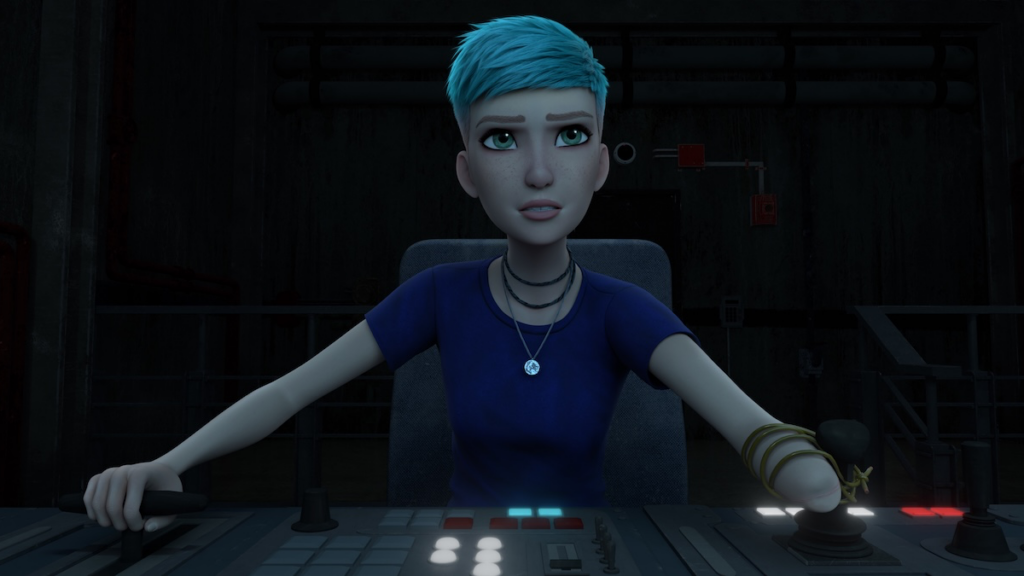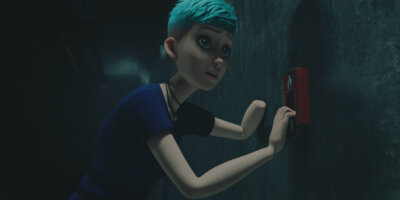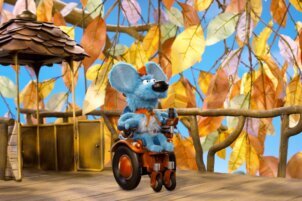
Brooklyn in “Jurassic World: Chaos Theory.” Season 2 is streaming now on Netflix.
DreamWorks Animation, Universal Pictures, and Amblin Entertainment’s “Jurassic World: Chaos Theory” picks up season two right where it left off, continuing its core themes of looking out for one another – whether it be a friend or a dinosaur – at any cost, and fighting for a version of the world you believe in. Airing on Netflix beginning October 17, the season is full of action, suspense and tender moments, as well as some laughs.
Strikingly, the last episode of season one had revealed that Brooklyn – the sixth member of “The Nublar Six,” a group of friends who survived Camp Cretaceous’ dinosaur-filled island together – was not dead like her friends and family had presumed. Brooklynn had been trying to investigate an underground dinosaur selling operation when things went awry. A dinosaur trained to attack came at her, biting off part of her arm. But luckily, a former DPW officer named Ronnie came to her rescue before anything further could happen.
Brooklynn’s journey as a new amputee following the attack, then, is central to the plot of the new season. And the Jurassic World: Chaos Theory team took care when weaving disability into the storyline.
Peter Lee, an amputee who first worked as a consultant and then transitioned to a permanent seat in the writers’ room, played a crucial role in getting it right.
This translated into an authentic portrayal that amputees and even those that aren’t amputees could relate to. “The elements we highlighted for Brooklynn (e.g. being underestimated, weird stares, strange physical pains and sensations) are all highly relatable for kids,” Lee explained in an interview with Disability Belongs. “As adults, I think we often forget the magnitude and speed with which kids transform emotionally, socially, and physically.”
As someone who became an amputee as a young adult, I could resonate with much of what Brooklynn was going through. A scene that particularly stood out to me was when Brooklyn was standing in a mirror practicing her initial interactions with family and friends. “Hey fam what’s up? Notice anything different? It’s the hair!” Relatably, she is trying to use humor to compensate for the true nerves she has surrounding these first meetings. Shortly following my amputation, I can remember having a running joke with a friend where I’d point out that it was “the first time we’ve hung out with me having one leg,” the first time we’d gone to our favorite food spot with me having one leg, and so on.
Something else that stood out to me was that the writers chose to show Brooklynn having an emotional reaction to waking up and seeing herself with a limb difference. It was an important start to the processing journey that ensues and speaks to the experience of some amputees.
Where the writers could have made Brooklynn wallow in sadness, they instead send the message that just because she lost a hand, she didn’t lose her spirit. Brooklynn is fiercely independent, brave, and conniving. Sure, she faces some extra challenges because of her disability, but she finds ways to get back to the lifestyle she wants to have for herself— one that involves fixing toasters, sneaking onto cross-continental ferries, and saving dinosaurs.
Lee sums up a similar thought when reflecting on Brooklynn’s character: “It gives audiences an opportunity to bear witness to the inherent humanity of disabled people. We are not lesser humans. We need not be pitied or feared.”
Lee adds that the series also “models social interactions (how-to and how-not-to) that can be instructive for folks who might feel nervous about real life interactions with disabled people.”
Where animation and screenwriting go far in building up Brooklynn’s character, it is voice actress Kiersten Kelly who completely brings Brooklynn to life. Her emotion in tender moments like when she first wakes up following the attack is conveyed perfectly, as are her tense yet exciting “undercover” moments as the action in the plot picks up.
Notably, Kelly is an actress with a very similar limb difference as Brooklynn. According to the Ruderman Foundation’s White Papers, less than a quarter of disabled characters were played by disabled actors in 2018, an issue called inauthentic casting. The move to cast Kelly then, is a triumphant step in the right direction when looking broadly at the film industry.
According to Kelly, inauthentic casting is “both frustrating and motivating.”
 “It’s frustrating because I would hope for things to be further along in the entertainment industry but then we have to remember the Americans with Disabilities Act (ADA), the first civil rights law protecting people with disabilities, wasn’t signed into law until 1990,” Kelly explains. “That law prohibits discriminating against people with disabilities in various areas including employment, public accommodations, etc. For the longest time, people in the disability community weren’t visible because of limited access and lack of equal opportunity. That created a view that we lack ability or don’t exist, and it takes a long time to shift that perspective.”
“It’s frustrating because I would hope for things to be further along in the entertainment industry but then we have to remember the Americans with Disabilities Act (ADA), the first civil rights law protecting people with disabilities, wasn’t signed into law until 1990,” Kelly explains. “That law prohibits discriminating against people with disabilities in various areas including employment, public accommodations, etc. For the longest time, people in the disability community weren’t visible because of limited access and lack of equal opportunity. That created a view that we lack ability or don’t exist, and it takes a long time to shift that perspective.”
Kelly also adds that she is motivated by the current shift in promoting authentic casting. “People learn from media, but people are also the ones creating what’s in media. We need allies, which leads me to why the history of inauthentic casting is motivating because I’m working in this industry at a time where a shift is happening. I am an actor with a disability who is part of an extremely successful franchise voicing a series regular character with a limb difference. Things are changing.”
According to Think Tank for Inclusion and Equity, just two percent of TV writers identify as disabled. Lee, who is an alumnus of the Disability Belongs Entertainment Lab, is helping to change these statistics. After Lee completed his work on Jurassic World: Chaos Theory, Disability Belongs connected Lee to another position as a staff writer for a different children’s animated show, where he is currently working.
Both Lee and Kelly described how having seen positive on-screen representation of their disability would have changed their experience growing up for the better.
For Kelly, she explains that being an actress was a dream of hers ever since she was little. But even as she danced, sang, and acted out emotions alongside nondisabled actors she was seeing on-screen, she says, “it all seemed just out of reach no matter what I did or how hard I worked.” However, “having someone on-screen that [she] could have related to would’ve felt less isolating and it would’ve showed possibility.”
Lee echoes these same points: “Having the opportunity to see my disability represented on-screen in a meaningful way would have profoundly diminished my sense of isolation and expanded my sense of what is possible for someone with limb loss.”
He remarks on feeling lucky to be a part of making that representation for younger audiences, and also feeling a responsibility to get it right.
“We rarely see disabled storylines, even though disability is incredibly common. The impact of excluding disabled folks from any space is that it perpetuates harmful stigmas — it sends the message that there’s something shameful about being disabled, so it should be hidden from view.”
The efforts of the Jurassic World: Chaos Theory team ultimately speak for themselves, whether it be the casting of a disabled actress or the authenticity of the storyline.
“We have moments that are disability specific as Brooklynn did experience a trauma and is now an amputee but it’s not her entire character arc,” Kelly said. “What I love about Brooklynn is [that] she is human. She’s not specifically a victim, a villain or a hero. Her story is filled with depth and color and that’s something I’m really excited for people to see.”
“Often, we [as people with limb differences] are seen as fragile, scary or someone to feel sorry for and I think Brooklynn’s story is a chance to change that perspective. I really appreciate the people around Brooklynn for not treating her differently after becoming an amputee as well. She is going through a new journey, but she is still a person with passions, talents and interests. She is not less than and her disability is not her entire identity.”
Watch Seasons 1 and 2 of “Jurassic World: Chaos Theory” on Netflix.






